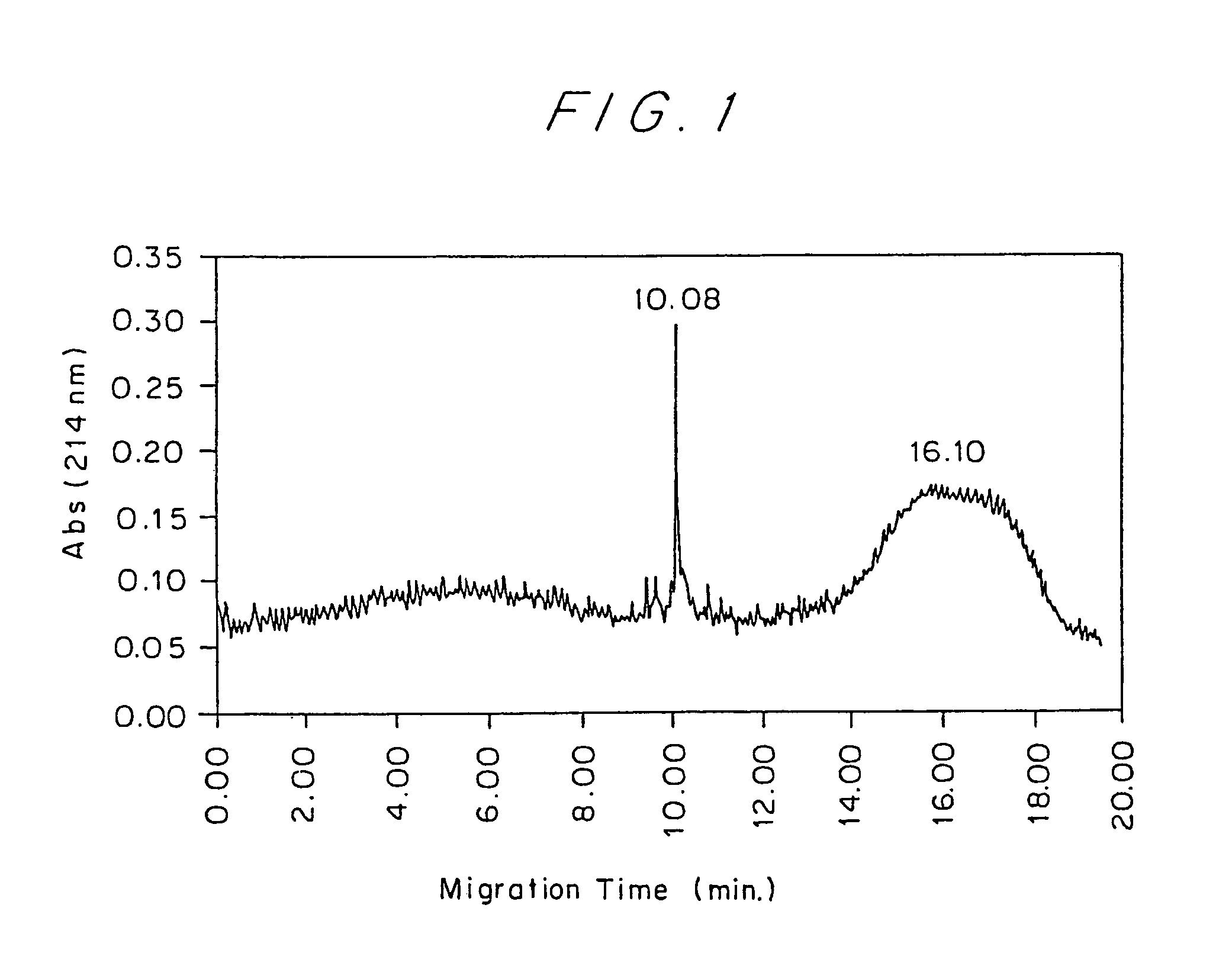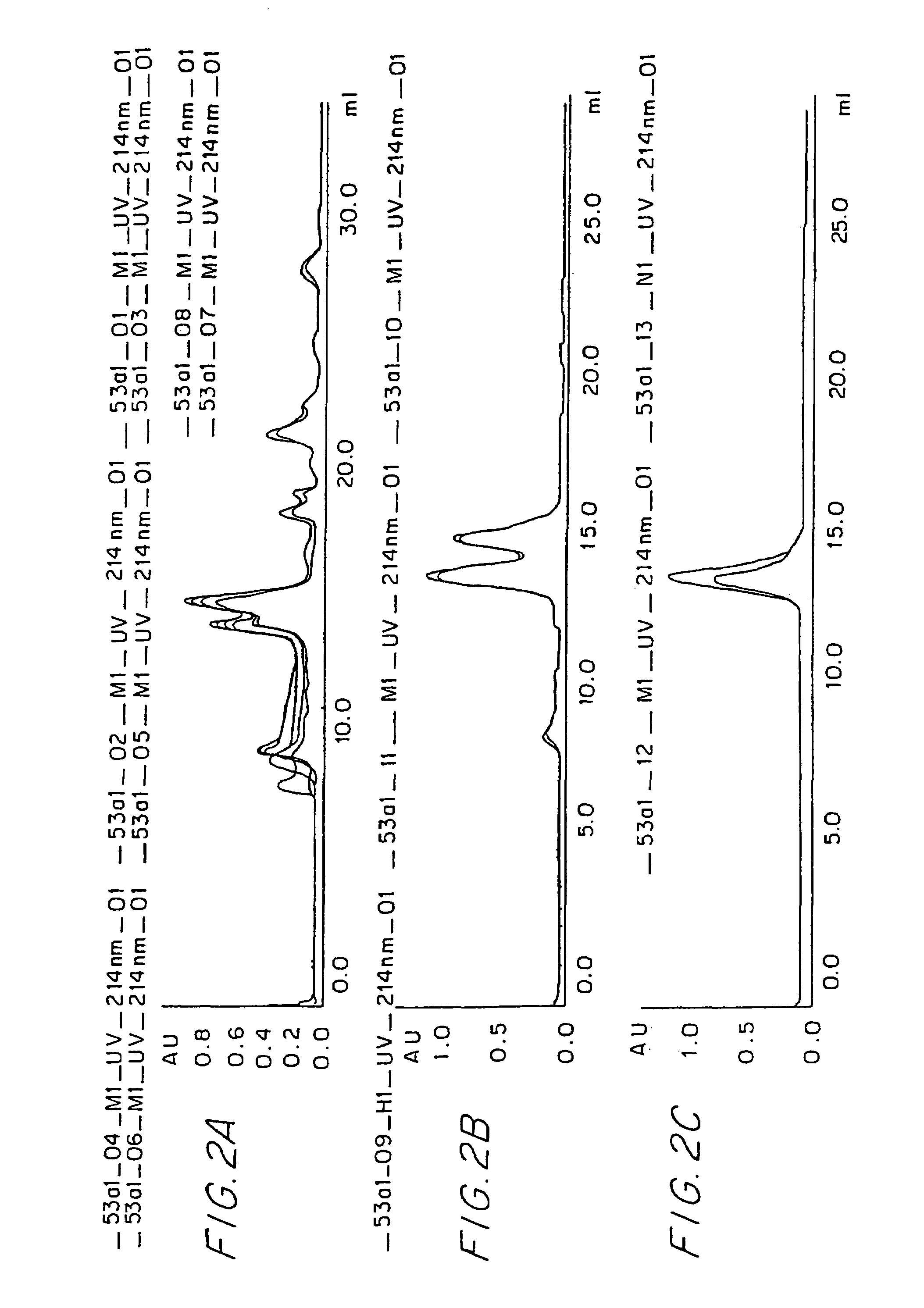Method for treating disorders and diseases treatable with human fibroblast interferon
a human fibroblast and interferon technology, applied in the field of polyolifn conjugates, can solve the problems of reduced activity and yield, increased solubility, and reduced number of conjugates that become almost inactive, and achieves increased stability, increased solubility, and increased effectiveness in vivo
- Summary
- Abstract
- Description
- Claims
- Application Information
AI Technical Summary
Benefits of technology
Problems solved by technology
Method used
Image
Examples
example 1
Preparation of PEG-IFN-β Conjugate
Modification of IFN-β with mPEG5k-OPSS
[0069]Recombinant human IFN-β, stable at a concentration of 0.37 mg / ml in 50 mM sodium acetate buffer, pH 3.6, was used for the preparation of a PEG-IFN-β conjugate. Approximately 1.0 ml of 6 M urea was added to 2 ml of IFN-β at a concentration of 0.37 mg / ml (0.74 mg, 3.7×1−8 moles). mPEG5K-OPSS was added in a molar excess of 50 moles to one mole of IFN-β and the two were allowed to react in a polypropylene vial for either 2 hours at 37° C. or 1 hour at 50° C. The reaction mixture was analyzed with Capillary Electrophoresis (CE) graph to determine the extent of PEG-IFN-β conjugate formation by the PEGylation reaction prior to any purification (FIG. 1). A typical yield for this reaction is 50% PEG-IFN-β. The reaction products were filtered from the reaction mixture with a 0.22 mm syringe filter and the filtered solution was then loaded onto a size exclusion column (either Superose 12 or Superdex 75, Pharmacia) an...
example 2
Biolocical Activity of the PEG-IFN-β Conjugate
[0071]To assess the effects of PEGylation on the anti-viral activity of human recombinant IFN-β, human WISH amniotic cells were preincubated with either freshly prepared IFN-β (same lot as used for PEGylation) or PEG-IFN-β conjugate. The IFN-β-mediated anti-viral activity, as measured by the WISH-VSV cytopathicity assay, was determined according to an anti-viral WISH bioassay developed based on the protocol of Novick et al., J. Immunol., 129:2244-2247 (1982). The materials used in this WISH assay is as follows:
[0072]WISH cells (ATCC CCL 25)
[0073]Vesicular Stomatitis Virus stocks (ATCC V-520-001-522), stored at −70° C.
[0074]IFN-β, human recombinant, InterPharm Laboratories LTD (32,075-type, Batch # 205035), 82×106 IU / ml, specific activity: 222×106 IU / mg
[0075]PEG-IFN-β conjugate as prepared in Example 1 and maintained in PBS, pH 7.4
[0076]WISH Growth medium (MEM high glucose with Earls salts +10% FBS+1.0% L-glutamine+Penicillin / Streptomycin...
example 3
In vitro Assays of the Relative Activity of PEG-IFN Samples
[0090]Relative bioactivity of PEG[30 kD]-IFN-β and PEG[2×20 kD]-IPN-β was determined by WISH assay using the standard protocol described in Example 2 (Table 2). Three independent assays were performed by three different individuals at separate times.
[0091]
TABLE 2Relative antiviral activity of PEG-IFN-βRelative Interferon Activity* (from three studies)SampleAssay 1Assay 2Assay 3Average (S.D.)PEG[30 kD]-IFN-β3.2× higher3.1× higher 1.8× higher3.0× (0.78) higherPEG[2 × 20 kD]-IFN-β4.2× higher1.3× higher0.85× higher2.1× (1.8) higher*EC50 doses compared with standard IFN-β included in each assay.**Comparison based on IFN-β concentration of 330 ug / ml. Stock concentrations of PEG[30 kD]-IFN-β (5.41 ug / ml) and PEG[2 × 20 kD]-IFN-β (6.86 ug / ml) were determined by AAA.
[0092]The binding of PEG-IFN-β to its receptor on cells was evaluated in the presence of a fixed amount of 125I-IFN-α2a. IFN-α2a was radiolabeled with 125I using the chlo...
PUM
| Property | Measurement | Unit |
|---|---|---|
| molecular weight | aaaaa | aaaaa |
| molecular weight | aaaaa | aaaaa |
| molecular weight | aaaaa | aaaaa |
Abstract
Description
Claims
Application Information
 Login to View More
Login to View More - R&D
- Intellectual Property
- Life Sciences
- Materials
- Tech Scout
- Unparalleled Data Quality
- Higher Quality Content
- 60% Fewer Hallucinations
Browse by: Latest US Patents, China's latest patents, Technical Efficacy Thesaurus, Application Domain, Technology Topic, Popular Technical Reports.
© 2025 PatSnap. All rights reserved.Legal|Privacy policy|Modern Slavery Act Transparency Statement|Sitemap|About US| Contact US: help@patsnap.com



